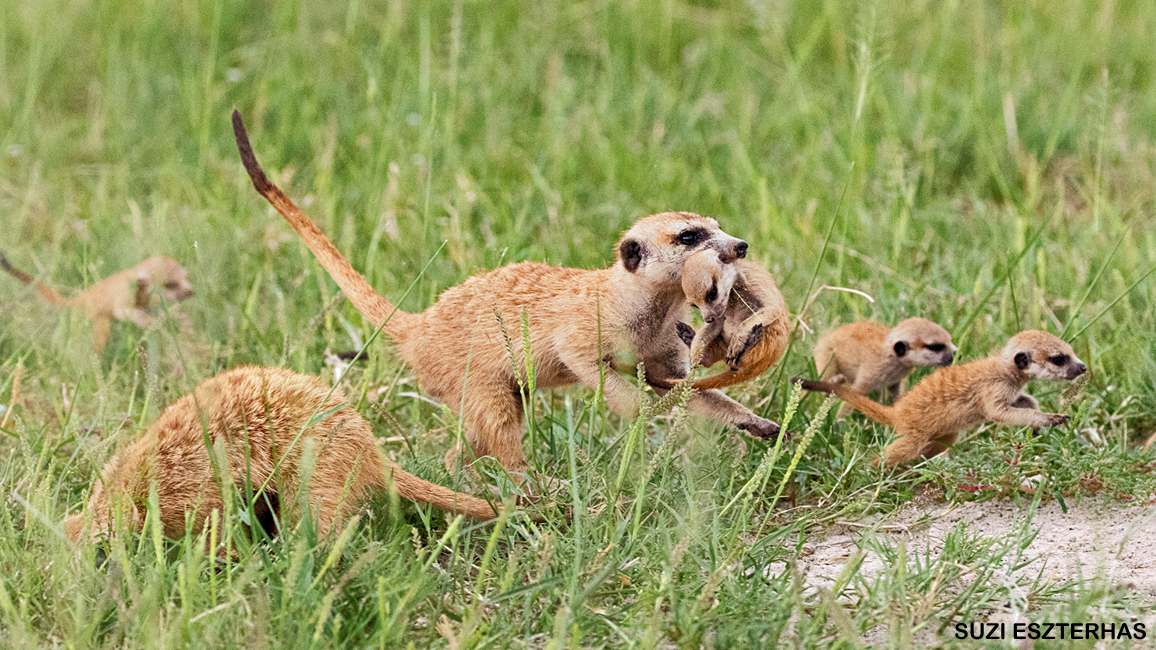
Meerkat Daycare
By Baruti the Meerkat, as told to Anne Cissel; Photos by Suzi EszterhasHi! I’m Baruti, and I’m looking after my younger brothers and sisters. Caring for meerkat babies, or pups, keeps us adults busy!

GUIDING
Instead of strapping them in a car seat, this is how WE safely move the kids around!
FEEDING
Lunchtime! No sippy cups here, though. My mom and aunt hang out while a new batch of pups nurses.
PROTECTING
Meerkats don’t have electronic alarms around their homes as some people do. So watching for enemies, such as birds of prey, is a big part of our job.

Team Parenting
Meerkat pups are very helpless. At birth, their eyes and ears are closed, and they each weigh about as much as a pencil! Lucky for them, they have a squad of adults ready to meet their every need.
Our home is in the deserts and grasslands of the southern part of Africa. It’s hot and dry, and enemies such as jackals and eagles threaten us every day. We live in groups of up to 50 meerkats, which are called mobs. Mob members band together to find food, watch for predators, and care for the pups. It’s teamwork that keeps us alive!
One male and one female meerkat are the leaders—and are usually the only ones to have pups. The rest of us know that we’d better keep the bosses’ kids healthy and safe.
Meerkat Mealtime
Healthy pups need to have full bellies. At first, mom—and sometimes aunts—will nurse them. But soon, solid food is on the menu. Most of the day, we adults run around foraging, which means searching for food. The pups can’t keep up with the mob yet, so one or two babysitters watch over them while the rest of us chow down.
We love to munch on beetles, spiders, scorpions, and other creepy-crawlies. We also sometimes eat small reptiles, eggs, fruit, plants, and other treats. Our sensitive noses sniff out food in the dirt and under rocks. We get most of our water from the food we eat.
We take turns bringing tasty morsels home to the pups. Sometimes, we’ll bring a still-alive insect to a pup, so it can practice trying to catch moving prey. One day, the pups will forage, too, still under the watchful eyes of the group.
VIDEO: Watch Silly Meerkat Babies!

Burrow Life
Early on, the pups stay safe below ground in burrows, which are networks of underground tunnels. Burrows aren’t just for pups, though. We adults dart down into them to escape predators and to keep cool. We also sleep there at night. Our burrows can have two or three levels, be six feet deep, and have up to fifteen entrances! Even at birth, pups have long, curved, sharp front claws that are specially made for making burrows and digging for insects. We all have special coverings for our ears and eyes to keep out dirt while digging.
Fight or Flee
Soon, the pups will need to learn to stand on their own two feet—really! We always have to be on the lookout for trouble: hungry predators and other meerkat mobs that want to take over our territory. So when we are out foraging, one or two of us will stand on hind legs and swivel our heads back and forth, looking for enemies.
If we spot something scary, we let out alarm calls that might sound to you like chirps and barks. To us, one call could mean, “Bird of prey approaching fast!” Another might be saying, “Enemy meerkats coming this way!” To escape danger, we hide in dead-end tunnels called bolt holes. The word “bolt” means to run as quickly as possible, which is exactly what we do! We build these bolt holes all around our territory so there’s always one close by.
But we don’t always run and hide. We have sharp teeth and sharp claws, and we can sometimes scare away a bigger animal because there are so many of us. The pups have a lot to learn about meerkat life. But the full-service daycare makes sure they’ll soon be ready to forage, dig, guard, and fight on their own!

















